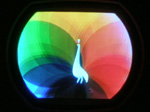How good can a picture be on a 15GP22? Click for 15GP22 screen shot of An account of the presentation of 1953 NTSC color television at the 2007 Early Television Convention
DIRECT view color television is becoming a thing of the past. Today acronyms such as DLP, HDMI, and SID abound in advertising, web blogs, big box stores, and in the shrinking magazine industry. But progress in technology decrees that its icons must eventually fade. Both the cathode ray tube and your favorite magazine are ebbing fast… and are already gone in many cases. This paper is an account of a resurrection: Through research accumulated during decades of slowly fading resources, through hardware restoration of 50-year-old technology, and through preservation of technological heritage by members of a devoted community, here is the story of a journey. How good can a picture be on a 15GP22? Historical Perspective. In 1954, two young men stood in front of dimly glowing television sets. One young entrepreneur hovered by a color television set in Philadelphia, while the other, still a student, watched in a darkened Omaha hotel ballroom.
These two fortunate gentlemen were witnessing history. Both were watching the first nationwide live color television network special: the now famous Rose Bowl Parade from Pasadena, California. In Philadelphia, young Philco television store owner Al Doernbach peered at the television manufacture’s prototype color set, while in Nebraska, young Ed Reitan watched the same picture on RCA’s Model 5 color set. Both were awed by the magic of vivid color pictures through the air. The direct view tricolor picture tube they watched was RCA’s successful and brilliant developmental model C73599. Four weeks later, this same tube with its letter-size viewing area would begin production with its official RETMA designation — 15GP22. Not only was it the first color picture tube to enter full production, it satisfied the requirements of the FCC-approved NTSC standards for color television. Although it produced a dim picture by today’s standards (hence the need for a darkened ballroom) it could reproduce a vivid range of striking colors. Three primary color phosphors — red, green, and blue — are used in a tricolor picture tube. But these original 15GP22 phosphor types that reproduce the full, wide gamut of NTSC color soon succumbed to more efficient types that produced much more intense light, and so watchers were no longer restricted to TV in darkened viewing areas. Bright pictures resulted from more efficient phosphor types, but the full gamut of colors, the NTSC color space, was quickly lost to antiquity. The Task. History is replete with tales of the wide color gamut of a 15GP22. Unfortunately, time has not been kind to the 15GP22. Design and manufacturing challenges associated with commercial production of the 15GP22 resulted in a flaw of sorts. The 15GP22 is subject to a failure of vacuum integrity. Where a vacuum must exist, nitrogen, oxygen, and all the components of air we breath leak into a 15GP22 rendering it lifeless and dark. Thousands were made back in 1954; today, the 15GP22 survivors that still glow number in the tens… there are perhaps as many as 50. To recall our 1954 heritage, and present a color television image as it was, requires legacy hardware restored to its original operational specifications. The TV. On March 25, 1954, RCA began producing the first of about 4000 color television sets, the RCA CT-100. Although sometimes cantankerous, this set is known to this day to be a standard of excellence. RCA scientists and engineers combined the best ideas from science and industry to produce the CT-100. It incorporated the finest technology of the day. It is capable of delivering a design-correct image. It is an important element of this 2007 resurrection. At the center of this project, happenstance has placed a CT-100 chassis that rolled down the RCA production line in Bloomington, Indiana, on the second day of production. Somehow this chassis, serial number B8000194, ended up in Texas, where in 2004 it was driven to New Jersey for restoration and calibration. Accomplished in 2005, the chassis underwent extensive evaluation and calibration with the expectation of achieving a chassis fully capable of generating wide-gamut NTSC signals for a 15GP22. Its tale is documented on the internet. The Tube. It is customary for makers of picture tubes to print the date of manufacture on each tube for purposes of both production control and warranty determination. The most recent data observed thus far is 1959. All others stem from 1954. To reproduce what a new color television set would display in those early years would require a proper chassis and a new picture tube. A new 15GP22.
This wonderful bit of luck brought together two of our three primary requirements, so only the availability of certified, period-NTSC color program material seemed left unfulfilled. Enter that young gentleman who watched the Rose Bowl Parade in Omaha 53-years earlier. Through years of eclectic research and dedication, Ed provided examples of early color video programs on DVD that duplicated the early color video signals enjoyed by those few who owned color television sets in 1954, 1955, and to the end of the 1950’s.
The
Accomplishment. A test fixture was
assembled and used for the 2007 ETF convention demonstration from the cabinet
of an unrestored CT-100 in the ETF
collection. This unrestored set — one of two CT-100’s in the museum’s
inventory — has a history. When new, it likely was used in a demonstration by
RCA of color television for military use. Whether or not it is that same one
in this August 1954 New York Times image from Steve Dichter is unknown. However, it came to the museum
by way of Wright-Patterson AFB in Ohio, where the Air Force museum is located.
For this demonstration, the chassis, yoke, and damaged 15GP22 were removed
from the cabinet after it was hauled from ETF storage to the back of the color television The museum’s ‘new’ 15GP22 installed in the fixture. A second task centered on the museum’s NOS 15GP22. By April 2006, the tube had arrived at the ETF museum from the RCA plant in Lancaster. Back then, during the 2006 convention, John Folsom tested the emission of the three guns, which appeared excellent. So, with Steve McVoy’s permission, on Friday May 3, 2007, the museum’s ‘new’ 15GP22 was installed in the fixture using the H-V insulator and mu-metal shield from the ETF set. A yoke and a purity-convergence assembly that matched the CTC-2 chassis used in the fixture were also installed. Finally, the early RCA production CTC-2 chassis is slipped into the cabinet. It is a chassis that was restored with an emphasis not only on operation, but on performance. To that end, no modern replacement inductors were used in video or chroma paths. A complete set of RCA ‘production’ inductors were assembled for this chassis. Sweep circuits were individually restored, performance tested, and calibrated. Chroma AFC circuitry was calibrated. Q filter operation was evaluated. A composite video interface was built and installed using a vintage Broadcast News article supplied by John Folsom. This allowed us to bypass the RF-IF link with the same circuitry used by early broadcasters. And finally, the video source hardware was performance-tested with a procedure and test DVD’s supplied by Wayne Bretl. Pictured on the left, Pete with the operating test fixture displaying a saturated green from a DVD test disk. Purity. When the test fixture was powered the first time, Steve Kissinger took over the reigns and performed the purity adjustments, and he did an excellent job. The red screen was unusually fine, virtually perfect. It was bright. Very bright. Without contamination. Perhaps all new 15GP22’s looked like this, but no one recalled seeing a 15GP22 with brighter red. The green field was also perfect. Blue purity too, but with a snag. Across the top of the blue field, and no other, there appeared a shadow. Purity itself was perfect on this blue field. However, if the red field was perfect, a shadow appeared on only the blue field. The result was a compromise. In screen photos it is evident that a purity issue appears as a thin crescent on the right side of the image. Click on this peacock for more detail. Time did not permit further evaluation of this anomaly. Click for 15GP22 Test Fixture Screen Shot Gray Scale. RCA generated the initial set-up and calibration procedures, but a Sams version is popular and was used in this fixture. It went quite well; gray scale was eyeball set and tracking adjustments flowed smoothly as performed by Pete. After adjustment, gray remains constant throughout its operating range — from about 20 percent up to 80 percent. The extreme ends of the brightness control show some tinting of the gray scale, but these are outside normal viewing parameters. Convergence. With a well calibrated set, the image on a 15GP22 is impressively sharp for the limited 3-MHz luminance bandwidth of a pre-comb-filter color set. For this demonstration, the viewing distance would be much greater, and so we, John Folsom and Pete Deksnis, did not fight the convergence till our normal expectations were achieved. Pictures of the screen may reveal the convergence compromise, but a typical viewer standing at demonstration-distance was not distracted by the softness. After the Accomplishment. On Sunday afternoon May 6th, only Chuck Azzalina, Wayne Bretl, Pete Deksnis, and Ed Reitan remained to dismantle the test fixture, but before that happened, interesting data describing the performance of a CT-100 were taken. Test signals from a Digital Video Essentials DVD were fed directly to the test fixture at the composite video input adapter. A modern colorimeter then determined luminance and CIE x, y coordinate points to accurately measure gray-scale tracking performance of the fixture. As reported above, the gray scale remained constant throughout its approximately 20- to 80-percent operating range as shown in the next table. Note the italicized brightness levels approximately increase in proportion with the 60- and 80-percent drive levels. Inspection of x and y columns shows stable gray from below 40 percent to 100 percent brightness. % x y fL 20 0.222 0.191 0.59 40 0.218 0.203 2.51 60 0.217 0.208 5.75 80 0.217 0.211 8.27 100 0.217 0.21 9.46 ETF 15GP22 Chromaticity. Hue and amplitude of primary colors were measured using the Digital Video Essentials DVD, which provides full screen primary color video at 100- and 75-percent levels. Results from the 100-percent brightness level tests are shown in the next table. CIE x,y values for NTSC are red: 0.67/0.33; green: 0.21/0.71; blue: 0.14/0.08. R 100% G 100% B 100% x= 0.606 0.252 0.166 y= 0.344 0.649 0.098 (May 6, 2007 ETF data) To test tracking, the brightness control was used to lower overall brightness by a random amount after all other chromaticity readings were taken. The 75-percent primary color levels were used to take the data. While the results were mixed, clearly two-thirds of the results tracked well with only the red shifting its x coordinate to 0.567 from 0.601 (back 0.034), and the green y coordinate shifting to 0.617 from 0.646 (down 0.029). All other shifts in coordinate values ranged from a maximum of 0.015 (green x) to a minimum of 0.001 (blue y). RED 75%/lobrt GRN 75%/lobrt BLU 75%/lobrt x= 0.601 0.567 0.253 0.268 0.166 0.163 y= 0.346 0.35 0.646 0.617 0.098 0.099 (May 6, 2007 ETF data) Illuminant C. With the day waning and time running out, the group made an effort to achieve what had been elusive three-days earlier when the museum’s CT-100 was measured with the colorimeter for gray scale. The 1953 NTSC standard specifies Illuminant C as gray. On the CIE diagram, Illuminant C falls at x=0.310 and y=0.316. Colorimeter-set Screen (pinkish) % x y fL 80 0.311 0.316 –
Those of us who are familiar with the blue-white of P4 phosphor and who are less familiar with the pinkish hue of true Illuminant C, may eyeball-adjust a color set to our familiar bluish gray. As shown in the above table, a correct Illuminant C gray scale finally beamed from the test fixture. Time had run out for the final four though, and so it will remain for another day to adjust gray-scale tracking on an Illuminant C compliant CT-100.
Participants include in
alphabetical order: Chuck Azzalina, Wayne Bretl, Pete Deksnis, John Folsom,
Steve Kissinger, Steve McVoy, Ed Reitan
|

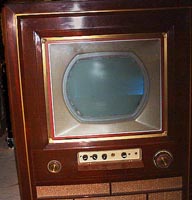
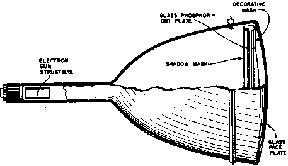
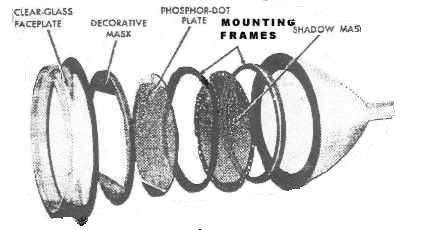

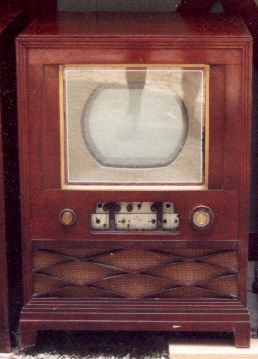
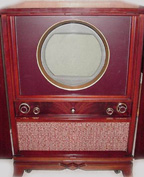
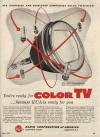
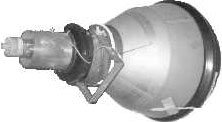
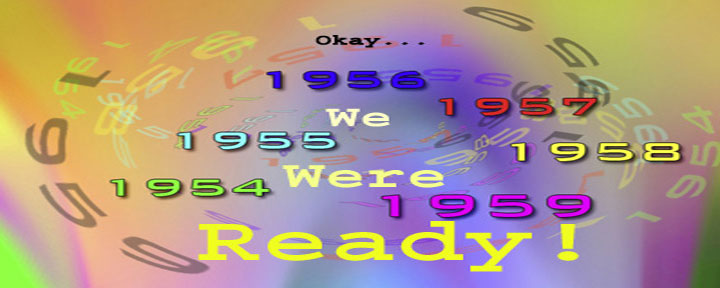
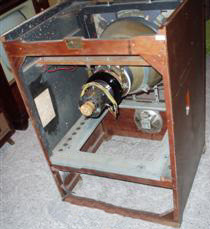 display area in the museum proper. This location would
allow a dozen or more viewers at a time to watch the
display area in the museum proper. This location would
allow a dozen or more viewers at a time to watch the 
